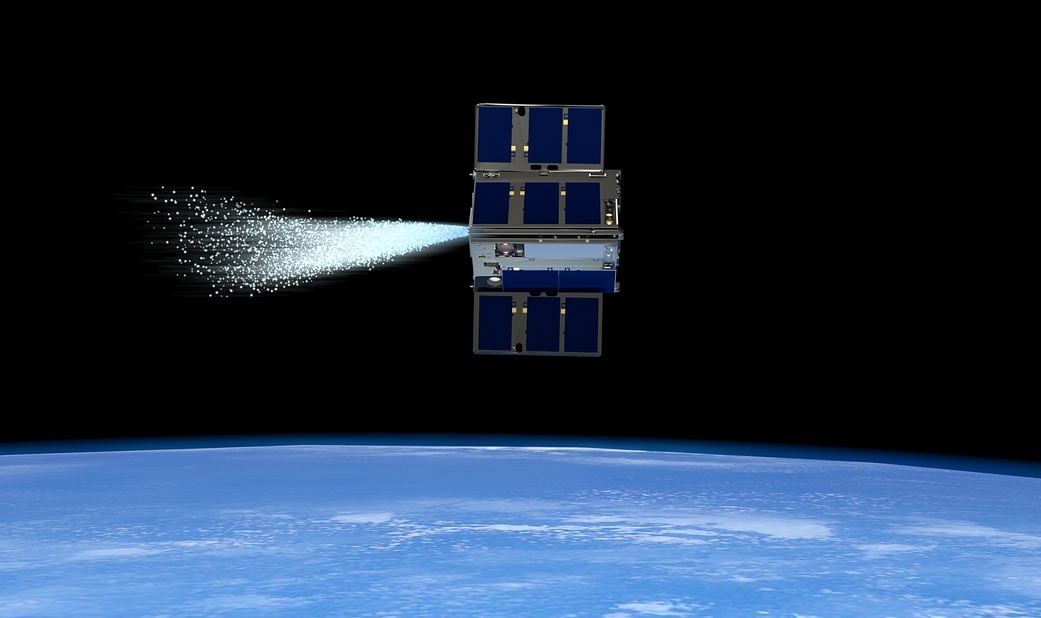Within the next fifteen years, NASA, China, and SpaceX plan to send the first crewed missions to Mars. In all three cases, these missions are meant to culminate in the creation of surface habitats that will allow for many returns and - quite possibly - permanent human settlements. This presents numerous challenges, one of the greatest of which is the need for plenty of breathable air and propellant. Both can be manufactured through electrolysis, where electromagnetic fields are applied to water (H2O) to create oxygen gas (O2) and liquid hydrogen (LH2).
While Mars has ample deposits of water ice on its surface that make this feasible, existing technological solutions fall short of the reliability and efficiency levels required for space exploration. Fortunately, a team of researchers from Georgia Tech has proposed a " Magnetohydrodynamic Drive for Hydrogen and Oxygen Production in Mars Transfer " that combines multiple functionalities into a system with no moving parts. This system could revolutionize spacecraft propulsion and was selected by NASA's Innovative Advanced Concepts (NIAC) program for Phase I development.
The proposal comes from Alvaro Romero-Calvo, an assistant professor at the Georgia Institute of Technology, and his colleagues from the Georgia Tech Research Corporation (GTRC). The system employs a magnetohydrodynamic (MHD) electrolytic cell, which relies on electromagnetic fields to accelerate electrically conductive fluid (in this case, water) without any moving parts. This allows the system to extract and separate oxygen and hydrogen gas in microgravity, removing the need for forced water recirculation and the associated equipment (i.e., pumps or centrifuges).
As a specialist in low-gravity science, fluid mechanics, and magnetohydrodynamics, Romero-Calvo and his team have spent many years investigating the applications of MHD systems for spaceflight. The need for a dedicated study to assess the concept's feasibility and integration into a suitable oxygen production architecture ultimately motivated their proposal. In a previous study, Romero-Calvo and co-author Dr. Katharina Brinkert (a professor of Chemistry at the University of Warwick) noted how water harvested in situ would reduce vehicle launch masses.
However, they also noted that operating this kind of machinery in microgravity presented many unknowns, most of which are not addressed by current research. In particular, they stressed how the absence of buoyancy in microgravity results in major technical challenges, like the need to detach and collect oxygen and hydrogen bubbles, which was traditionally addressed using forced water recirculation loops. However, they argued, this leads to liquid management devices composed of multiple elements and moving parts, which are complex, inefficient, and unreliable in space. As Romero-Calvo explained in a recent Georgia Tech news release:
"The idea of using MHD forces for liquid pumping is explored in the 1990 thriller *The Hunt for Red October*, where a stealth soviet submarine powered by an MHD drive defects to the United States. Although it's fun to see Sean Connery playing the role of a Soviet submarine commander, the truth is that submarine MHD propulsion is very inefficient. Our concept, on the contrary, works in the microgravity environment, where the weak MHD force becomes dominant and can lead to mission-enabling capabilities."
Instead of traditional recirculation loops, the proposed MHD system relies on two distinct mechanisms to separate oxygen and hydrogen from water. The first comes from diamagnetic forces, which arise in the presence of strong magnetic fields and result in a magnetic buoyancy effect. Second, there are Lorentz forces, which are a consequence of the imposition of a magnetic field on the current generated between two electrodes. As Romero-Calvo noted in their proposal paper:
"Both approaches can potentially lead to a new generation of electrolytic cells with minimum or no moving parts, hence enabling human deep space operations with minimum mass and power penalties. Preliminary estimations indicate that the integration of functionalities leads to up to 50% mass budget reductions with respect to the Oxygen Generation Assembly architecture for a 99% reliability level. These values apply to a standard four-crew Mars transfer with 3.36 kg oxygen consumption per day."
If successful, this HMD system would enable the recycling of water and oxygen gas in long-term space travel. Romero-Calvo and other colleagues at the Daniel Guggenheim School of Aerospace Engineering at Georgia Tech demonstrated in another paper that this technology could also have applications for water-based SmallSat propulsion and other mission profiles where ISRU is a must. At present, Romero-Calvo and his colleagues have formulated the concept and have developed analytical and numeral models.
The next step will involve the team and their partners at Giner Labs (a Massachusetts-based electrochemical R&D firm) conducting feasibility studies. Over the next nine months, they will receive $175,000 to explore the system's overall viability and technology readiness level. These will consist primarily of computational studies but will include prototypes testing key technologies here on Earth. As a Phase I proposal, they will also be eligible to compete for Phase II funding worth $600,000 for a two-year study.
An early demonstrator of this technology was tested aboard the 24th flight of the New Sheperd (NS-24), an uncrewed mission that launched on December 19th, 2023. With support from Blue Origin and the American Society for Gravitation and Space Research (ASGSR), Romero-Calvo's team tested how magnets electrolyzer water in microgravity conditions. The data from this flight and the forthcoming tests will inform an HMD electrolyzer prototype and could lead to a system integrated aboard future space missions. Said Romero-Calvo:
"We were studying the fundamental magnetohydrodynamic flow regimes that arise when we apply a magnetic field to water electrolyzers in spaceflight conditions," Romero-Calvo explained. "The Blue Origin experiment, in combination with our current collaboration with Prof. Katharina Brinkert ’ s group at the University of Warwick, will help us predict the movement of oxygen bubbles in microgravity and it hints at how we can build a future water electrolyzer for humans."
Further Reading: NASA*, Georgia Tech*
 Universe Today
Universe Today

